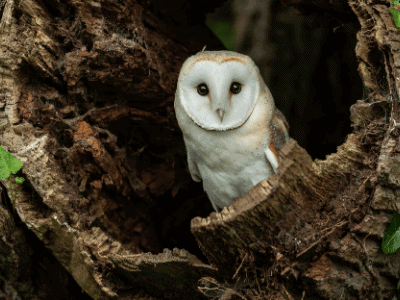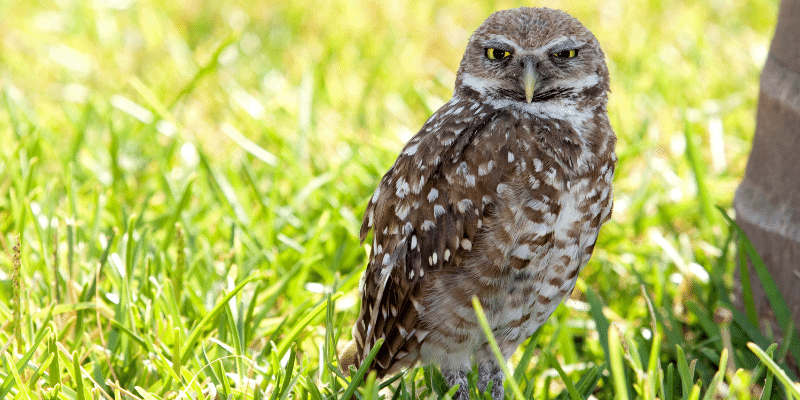Did you know that Florida is home to seven different owl species? Owls are considered as one of the most enthralling and fascinating bird families, loved and preferred by most bird-watchers.
If you are an owl fan who happens to visit Florida anytime soon, you will be surprised at the variety of species you will encounter.
Let’s take a look at the different species of owls found in Florida and what you need to know about them.
1. Barn Owl
The Barn Owl measures 12-16 inches in length, 40-59 inches in wingspan, and weighs about 12-25 oz.

You can find this particular species of owls all around the year in various parts of Florida and most of North America. You can find Barn Own in Florida at farms, suburbs, or forest areas.
Barn Owls usually prefer inhabiting isolated barns; that’s where they got their name from.
Farmers prefer barn Owls as they help keep their barns and fields free from all mice and rats. They reduce the chances of diseases in barn animals.
While nocturnal birds are scattered all across Florida, their population has gradually started declining. This is because they have limited habitat options as their existing habitats are getting destroyed.
Barn Owls have heart-shaped faces, usually white or pale white with dark brown edges. They are also called Monkey-faced Owls for their unique features.
A fascinating fact to consider about barn owls is that their face diverts sound to their ears. This enables them to be the most effective hunter-by-sound ever. Their hearing is so phenomenal that they can easily trace small animals who are tucked under thick bushes or layers of snow.
2. Eastern Screech Owl
The Eastern Screech Owl measures 6-9 inches in length, 18-25 inches in wingspan, and weighs about 4-9 oz.

As the name suggests, the Eastern Screech-owl is widely scattered across the eastern half of the United States and similarly all across Florida. This owl species is particularly famous for its loud screeching calls.
The birds use these sharp sounds as a defense mechanism when caught in a dangerous situation.
The habitat of Eastern Screech Owls is in nesting boxes. The mating pairs of these birds are inherently monogamous, which means that they mate with their partner for life.
Eastern Screech Owls are known for making a unique high-pitched hoot sound called a tremolo. Screech Owl pairs use this sound for mating. At times, it gets as loud as the mating sound of toads.
3. Great Horned Owl
The Great Horned Owl measures 18-25 inches in length, 40-57 inches in wingspan, and weighs about 32-88 oz.

The Great Horned Owl is considered the most common species of owl available not just in Florida but worldwide. They are found all around the year in Florida.
Great Horned Owls are densely populated all across North America and can also be found in the Arctic south and nearby tropical areas.
In appearance, Great Horned Owls is large in size and looks wonderfully fierce and majestic. Their face is usually covered with black and rust-colored stripes, making it easier for them to camouflage.
Great Horned Owls can inhabit anywhere, given that there are trees and nesting sites around.
Be it deserts, grasslands, forests, swamps, or even urban cities, these majestic creatures can easily survive anywhere.
When it comes to having predators, the Great Horned Owl only has a handful. This majestic bird feeds usually attacks small mammals and rodents. In addition, it can also hunt other small birds or even owls in some cases.
When it comes to calling sounds, female Great Horned Owls are higher-pitched than male ones. This owl species is known to have the best hooting sound compared to others. Their night calls can easily be heard even from several miles away.
4. Burrowing Owl
The Burrowing Owl measures 7-10 inches in length, 20-22 inches in wingspan, and weighs about 5-5.5 oz.

The Burrowing Owl can be found all around the year across most parts of Florida. That is, except for the northern side and panhandle, where you can rarely spot them. To catch a glimpse of the Burrowing Owl, look around open grasslands or desert areas.
As opposed to other owl species that prefer dwelling in trees, Burrowing Owls prefer living underground. These owls make their nests in burrows inside the grounds that dogs, rabbits, or squirrels usually dig.
These burrows provide a lot of room for storing food. Burrowing owls are known for storing up to a hundred mice to be well-prepared for an emergency.
When it comes to hunting, Burrowing Owls have a unique strategy for catching their prey’s attention. They use other dead animals’ waste and scatter it across the ground, near their burrows. This will lure their prey like dung beetles and other insects.
Burrowing Owls are not very loud or vocal with their calls. You will hear a Burrowing Owl’s call that is mostly heard during mating season or when a male owl is attacked.
5. Barred Owl
The Barred Owl measures 16-20 inches in length, 39-44 inches in wingspan, and weighs about 16-37 oz.

The Barred Owl is most commonly found across Florida and the eastern side of the United States. Barred Owls are nocturnal.
Hence their activity increases at night time. This owl species prefers habitat in large and dense forests and sometimes nest boxes.
One distinctive feature that Barred Owls have is their unique call sound. The sound seems like they are saying, “Who cooks for you? Who cooks for you all?”
This sound is synonymous with all Barred Owls, which you can recognize instantly even from a distance.
You can keep an eye out for the hoot sounds of Barred Owls during the day as well as night as they are known to mate throughout the day.
Barred Owls are one of the most inquisitive species of owls. If you come across a Barred Owl, they will quietly observe you and fly off to a nearby location where they can continue observing you.
6. Short-eared Owl
The Short-eared Owl measures 13-17 inches in length, 33-41 inches in wingspan, and weighs about 7-17 oz.

The Short-eared Owl can be most commonly found throughout the state of Florida in winter. These owls prefer hunting early morning or around dusk. Hence they are usually seen in daylight.
They prefer open grounds and fields for hunting, so you may usually find them at airports.
Short-eared Owls are known for their unique hunting style. They fly very close to the ground to catch their prey. Their favorite daytime prey is voles, but they also hunt for rodents, small birds, and insects.
Short-eared Owls are one of those rare owl species that are not so vocal. Their mating sound is similar to that of a cat.
7. Northern Saw-whet Owl
The Northern Saw-whet Owl measures 7-9 inches in length, 16-19 inches in wingspan, and weighs about 2-5.5 oz.

The Northern Saw-whet Owl is most commonly seen across northern Florida in winter. These owls are the smallest in comparison to all other owl species found in Florida.
Although small in size, Northern Saw-whet Owls have big round heads and large eyes.
Owing to their small size, it is quite difficult to spot a Northern Saw-whet Owl. If you can learn the call of these owls, you might be able to locate them, especially at night time.
They have a unique call similar to the high-pitched ‘too-too’ sound of a sharpened blade using a whetstone.
This is where these owls derived their name from. The chances of catching a glimpse of the Northern Saw-whet Owls increase in early summer as that is when their call frequency increases.
The female Northern Saw-whet Owl is famous for her tidy nest. She leaves the baby owls when they are about two to three weeks old, and then the male counterpart has to feed them until they are ready to leave the nest in another week or so.
Since the young owls are unable to clean after themselves, leaving the nest dirty and grimy, the female leaves them in search of a clean nest elsewhere.
Northern Saw-whet Owls are brown in color, making it easier for them to camouflage with the trees around the forest. These nocturnal animals like to confide within themselves and avoid getting noticed by laying low and only being active during nighttime.
Summary
Florida is the ideal location for bird-watchers particularly interested in owls and discovering various owl species.
Most of the owl species are scattered across the northern part of Florida.
We will recommend you visit Florida in winter to increase your chances of catching a glimpse of your favorite owl species. Good luck with your quest!
Other articles you may also like:

